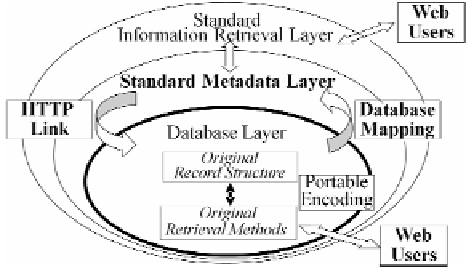Information Technology Reference
In-Depth Information
The temporal axis arranges objects by time, which corresponds to calendars. A
calendaring operation extracts objects that are distributed within a particular section
on the axis (i.e., a particular period). A 2D plane spanned by the subject axis and the
temporal axis includes calendars about particular subjects and periods (subject
calendars). These calendars correspond to “layers” of temporal information tools.
HuTime is a temporal information tool developed by the H-GIS, which will be
explained in Chapter 4. Zoom-in operation enlarges a particular period of a calendar
in great detail. Zoom-out is the opposite operation, showing a broad sweep of history.
Data mining is to find patterns from distribution of objects on a calendar such as
randomness, coherency, periodicity and decrement from one time point, and to find
patterns between calendars such as coexistence and transition.
A 2D plane spanned by the spatial axis and the temporal axis includes
spatiotemporal layers; there are no traditional tools (e.g., maps, calendars, GIS tools)
corresponding to this plane. Tools that can treat these layers are innovative, which
will be discussed in Chapter 6.
3 Resource Sharing Systems and Metadata
Variety types of databases have been created as the result of research activities. These
databases must be expected to be the basis of area studies. However, one database
cannot always hold all related resources, for example, users must visit many databases
to make up the whole map of South East Asia. These users must be disappointed.
Since each database is designed and built based on conventions of each institution
and/or discipline, even the same materials are organized differently by databases. That
is, locations, metadata, languages, vocabularies, terminologies, and retrieval
procedures (i.e., specifications) are different from databases, and users have to learn
specifications of all databases they want to retrieve data. A “Resource Sharing System
(RSS)” is developed to solve these problems by integrating databases on the Internet.
Fig. 3.
Resource Sharing Data Model


